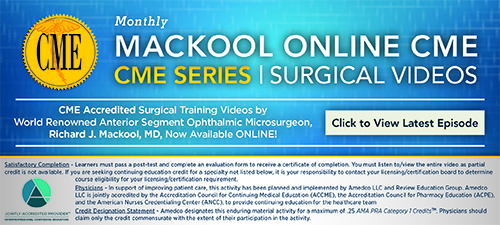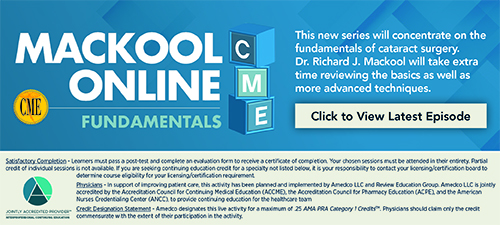| |
|
|
|
| Vol. 20, #47 • Monday, November 9, 2020 |
|
NOVEMBER IS DIABETIC EYE DISEASE AWARENESS MONTH
|
|
|
| |
|
Using OCT as a Surrogate of ICP in Idiopathic Intracranial Hypertension
Researchers wrote of the unmet need for noninvasive biomarkers of intracranial pressure (ICP), which manifests as papilledema that can be quantified by optical coherence tomography imaging. They aimed to determine whether OCT of the optic nerve head in papilledema could act as a surrogate measure of ICP.
The longitudinal cohort study used data collected from three randomized clinical trials conducted between April 1, 2014, and August 1, 2019. Participants who were female and had active idiopathic intracranial hypertension were enrolled from five National Health Service hospitals in the United Kingdom. Automated perimetry and OCT imaging were followed immediately by ICP measurement on the same day. Cohort 1 used continuous sitting telemetric ICP monitoring (Raumedic Neurovent P-tel device) on one visit. Cohort 2 was evaluated at baseline, and after three, 12 and 24 months, and underwent lumbar puncture assessment of ICP.
Researchers correlated OCT measures of the ONH and macula with ICP levels, Frisén grading and perimetric mean deviation. The OCT protocol included the peripapillary retinal nerve fiber layer, ONH and macular volume scans (Spectralis, Heidelberg Engineering). Researchers validated all scans for quality and re-segmented them manually when required.
A total of 104 women were recruited. Here were some of the findings:
• Among cohort 1 (n=15; mean [SD] age, 28.2 [9.4] years), the range of OCT protocols was evaluated, and ONH central thickness was found to be most closely associated with ICP (right eye: r=0.60, p=0.02; left eye: r=0.73, p=0.002).
• Subsequently, findings from cohort 2 (n=89; mean [SD] age, 31.8 [7.5] years) confirmed the correlation between central thickness and ICP longitudinally (12 and 24 months).
• Bootstrap surrogacy analysis noted a positive association between central thickness and change in ICP at all points (e.g., at 12 months, a decrease in central thickness of 50 μm was associated with a decrease in ICP of 5 cm H2O).
In this study, researchers found that ONH volume measures on OCT (particularly central thickness) reproducibly correlated with ICP, and surrogacy analysis demonstrated their ability to inform ICP changes. They wrote that the findings indicated OCT has the utility to monitor papilledema and also noninvasively prognosticate ICP levels in idiopathic intracranial hypertension.
SOURCE: Vijay V, Mollan SP, Mitchell JL, et al. Using optical coherence tomography as a surrogate of measurements of intracranial pressure in idiopathic intracranial hypertension. JAMA Ophthalmol 2020; Oct 22. [Epub ahead of print].
|
|
|
|
|
| |
Complimentary CME Education Videos
|
|
|
|
| |
|
Nonperfusion Assessment in Retinal Vein Occlusion
Investigators compared widefield optical coherence tomography-angiography to ultra-widefield fluorescein angiography (UWFA) in the assessment of nonperfusion in retinal vein occlusion.
The cross-sectional study examined 43 eyes of 43 RVO patients using widefield OCTA (Plexelite, Carl Zeiss Meditec) with a panoramic montage of five 12 x 12 mm images and UWFA (Optos, 200 degrees). Investigators performed qualitative analysis according to nonperfusion areas (cutoff: three disc areas) on widefield OCTA. The quantitative analysis assessed vascular density (VD) on the widefield OCTA and ischemic index (ISI) on UWFA.
Here were some of the findings:
• ISI on UWFA and VD in the superficial and deep plexus correlated significantly (p=0.019, r=0.357 and p<0.013, r=0.375, respectively).
• The qualitative classification on widefield OCTA and ISI on UWFA correlated significantly (p<0.001, r=0.618).
• For the detection of marked nonperfusion (ISI ≥25 percent), widefield OCTA had a sensitivity of 100 percent and a specificity of 64.9 percent.
Investigators wrote that the presence of nonperfusion on UWFA correlated with widefield OCTA and that OCTA could help to identify high-risk RVO patients who might benefit from a further evaluation using fluorescein angiography.
SOURCE: Glacet-Bernard A, Miere A, Houmane B, et al. Nonperfusion assessment in retinal vein occlusion. Retina 2020; Oct. 20. [Epub ahead of print].
|
|
|
|
|
|
|
| |
Complimentary CME Education Videos
|
|
|
|
|
| |
|
Novel Confocal Microscopy Imaging Protocol for DED
Scientists assessed the reproducibility of a novel standardized technique for capturing corneal sub-basal nerve plexus images with in vivo corneal confocal microscopy, and compared nerve metrics captured with the method in individuals with dry eye and controls.
Cases and controls were recruited based on their International Statistical Classification of Diseases and Related Health Problems (ICD-10) diagnoses. Participants completed the following three ocular symptom questionnaires: Ocular Surface Disease Index; Neuropathic Pain Symptom Inventory; and Dry Eye Questionnaire 5. A novel eye fixation-grid system was used to capture 30 standardized confocal microscopy images of the central cornea. Each participant was imaged twice by different operators. Seven quantitative nerve metrics were analyzed using automated software (ACCmetrics, Manchester, United Kingdom) for all 30 images and a six-image subset.
Forty-seven participants were recruited (25 classified as dry eye and 22 controls). Here were some of the findings:
• The most reproducible nerve metrics were corneal nerve fiber length [intraclass correlation (ICC)=0.86], corneal nerve fiber area (ICC=0.86) and fractal dimension (ICC=0.90).
• Although differences weren’t statistically significant, all mean nerve metrics were lower in those with dry eye compared with controls.
• Questionnaire scores didn’t significantly correlate with nerve metrics.
• Reproducibility of nerve metrics was similar when comparing the entire 30-image montage to a central six-image subset.
Scientists concluded that the standardized confocal imaging technique coupled with quantitative assessment of corneal nerves produced reproducible corneal nerve metrics, even with different operators. They added that no statistically significant differences in in vivo corneal confocal microscopy nerve metrics were observed between participants with dry eye and control participants.
SOURCE: Takhar JS, Joye AS, Lopez SE, et al. Validation of a novel confocal microscopy imaging protocol with assessment of reproducibility and comparison of nerve metrics in dry eye disease compared with controls. Cornea 2020; Oct 9. [Epub ahead of print].
|
|
|
|
|
| |
|
Automated Quantification of Macular Fluid & Anti-VEGF Therapy Response
Researchers objectively assessed disease activity and treatment response in patients with retinal vein occlusion, neovascular age-related macular degeneration and center-involved diabetic macular edema, using artificial intelligence-based fluid quantification.
The post hoc analysis (11,151 spectral-domain optical coherence tomography volumes) involving five clinical multicenter trials included 2,311 patients who received a flexible anti-vascular endothelial growth factor therapy over a 12-month period. Fluid volumes were measured with a deep learning algorithm at baseline/months one, two, three and 12, for three concentric circles with diameters of 1, 3 and 6 mm (fovea, paracentral ring and pericentral ring), as well as four sectors surrounding the fovea (superior, nasal, inferior and temporal).
Here were some of the findings:
• In each disease, at every timepoint, most intraretinal fluid (IRF) per square millimeter was present at the fovea, followed by the paracentral ring and pericentral ring (p<0.0001).
• This was also the case for subretinal fluid (SRF) in RVO/DME (p<0.0001), but patients with nAMD showed more SRF in the paracentral ring than at the fovea up to month three (p<0.0001).
• Between sectors, patients with RVO/DME showed the highest IRF volumes temporally (p<0.001/p<0.0001).
• In each disease, more SRF was consistently found inferiorly than superiorly (p<0.02).
• At months one and 12, researchers reported the following median reductions of initial fluid volumes.
o For IRF: RVO, 95.9 and 97.7 percent; nAMD, 91.3 and 92.8 percent; and DME, 37.3/69.9 percent, respectively.
o For SRF: RVO, 94.7 and 97.5 percent; nAMD, 98.4 and 99.8 percent; and DME, 86.3 and 97.5 percent, respectively.
Researchers reported that fully-automated localization and quantification of IRF/SRF over time shed light on the fluid dynamics in each disease. They found a specific anatomical response by IRF/SRF to anti-VEGF therapy in all diseases studied.
SOURCE: Michl M, Fabianska M, Seeböck P, et al. Automated quantification of macular fluid in retinal diseases and their response to anti-VEGF therapy. Br J Ophthalmol 2020; Oct 21. [Epub ahead of print].
|
|
|
|
|
|
|
|
| |
Advertisement
|
|
|
|
|
Industry News
Outlook Completes Patient Enrollment for ONS-5010/Lytenava Safety Study
Outlook Therapeutics completed patient enrollment for its open-label safety study evaluating ONS-5010/Lytenava (NORSE THREE). A total of 195 subjects were enrolled with a range of retinal diseases for which an anti-VEGF drug is a therapeutic option, including wet age-related macular degeneration, diabetic macular edema and branch retinal vein occlusion. Subjects are receiving three monthly intravitreal doses of ONS-5010/Lytenava. Data will support a Biologics License Application, scheduled for FDA submission in the second half of 2021, the company says.
Read more.
Genentech Announces AAO Schedule of Discussions/Presentations
Genentech announced the following activities at the virtual annual American Academy of Ophthalmology meeting to be held November 13 to 15:
• A panel discussion on increasing diversity and inclusion in ophthalmology: November 15, 8:35 a.m. PT/11:35 a.m. ET;
• A talk on the Home Vision Monitor app: November 13, 10:45 a.m. PT/1:45 p.m. ET;
• A presentation on Phase II BOULEVARD data for faricimab in DME given by Karl Csaky, MD, PhD, Retina Foundation of the Southwest, available on demand; and
• A presentation of Phase III Archway data on the Port Delivery System with ranibizumab (PDS) by Nancy Holekamp MD, Pepose Vision Institute, available on demand.
Ocular Therapeutix Receives Category I CPT Code from AMA
Ocular Therapeutix announced that its been allowed to create a Category I Current Procedural Terminology procedure code by the American Medical Association. Effective January 1, 2022, the code will replace the Category III CPT code (0356T) for the administration of drug-eluting intracanalicular inserts, including Dextenza (dexamethasone ophthalmic insert) 0.4 mg. Read more.
MeiraGTx Announces Data from AAV-RPGR to be Presented at AAO
MeiraGTx Holdings announced that 12-month results from the ongoing Phase I/II clinical trial of AAV-RPGR, an investigational gene therapy for the treatment of X-linked retinitis pigmentosa, will be presented during an oral session at the virtual American Academy of Ophthalmology meeting. MeiraGTx recently announced six- and nine-month data from the ongoing Phase I/II MGT009 clinical trial demonstrating AAV-RPGR was generally well-tolerated and produced significant improvement in vision. Read more.
reVision’s REV-0100 Receives FDA Rare Pediatric Disease and Orphan-Drug Designation
reVision Therapeutics announced the FDA granted the company's request to designate REV-0100 as an Orphan-Drug and a Rare Pediatric Disease Drug for the treatment of Stargardt’s disease. REV-0100 is a potential therapy for patients with Stargardt’s that’s designed to bind and clear a toxic lipid called lipofuscin, which can accumulate in Stargardt’s patients and lead to cell death and retinal degeneration. Read more.
|
|
|
|
|
|
| |
Review of Ophthalmology® Online is published by the Review Group, a Division of Jobson Medical Information LLC (JMI), 19 Campus Boulevard, Newtown Square, PA 19073.
To subscribe to other JMI newsletters or to manage your subscription, click here.
To change your email address, reply to this email. Write "change of address" in the subject line. Make sure to provide us with your old and new address.
To ensure delivery, please be sure to add reviewophth@jobsonmail.com to your address book or safe senders list.
Click here if you do not want to receive future emails from Review of Ophthalmology Online.
Advertising: For information on advertising in this e-mail newsletter or other creative advertising opportunities with Review of Ophthalmology, please contact sales managers Michael Hoster, Michele Barrett or Jonathan Dardine.
News: To submit news or contact the editor, send an e-mail, or FAX your news to 610.492.1049
|
|
|
|
|
|
|
|